1. What is XGS-PON?
XGS-PON, part of the Gigabit-capable PON (G-PON) family, is an advanced standard for Passive Optical Networks (PON) designed to facilitate higher-speed 10 Gbps symmetrical data transfer. PON is fiber network characterized by a point to multipoint architecture. G-PON, denoting Gigabit PON or 1 Gigabit PON, is the precursor. The “X” in XGS signifies 10, and “S” represents symmetrical, making XGS-PON synonymous with 10-gigabit capable symmetrical PON. Unlike its predecessor, XG-PON, which was non-symmetrical, XGS-PON ensures symmetrical 10 Gbps connectivity, eliminating the upstream speed limitation of 2.5 Gbps. This evolution marks a significant advancement in PON deployment for high-speed fiber networks.
Both XG-PON and XGS-PON belong to the GPON (Gigabit PON) series. From the technical roadmap, XGS-PON is the technological evolution of XG-PON.
Both XG-PON and XGS-PON are 10G PONs and facilitate 10-gigabit capable symmetrical data transfer. The main difference is: XG-PON is an asymmetric PON, and the uplink/downlink rate of the PON port is 2.5G/10G; XGS-PON is a symmetrical PON, and the uplink/downlink rate of the PON port is 10G/10G.
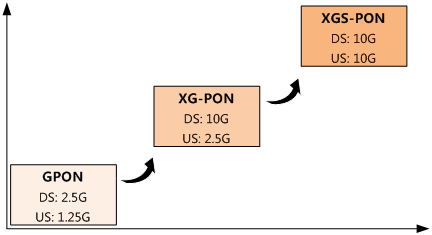
| Technology | GPON | XG-PON | XGS-PON | |
| Technical standard | G.984 | G.987 | G.9807.1 | |
| Line rate (Mbps) | Downlink | 2488 | 9953 | 9953 |
| Uplink | 1244 | 2488 | 9953 | |
| Maximum split ratio | 128 | 256 | 256 | |
| Maximum transmission distance (km) | 20 | 40 | 40 | |
| Data packaging | GEM | XGEM | XGEM | |
| Available broadband (Mbps) | Downlink | 2200 | 8500 | 8500 |
| Uplink | 1000 | 2000 | 8500 | |
| Working center wavelength (nm) | Downlink | 1490 | 1577 | |
| Uplink | 1310 | 1270 | ||
The main PON technologies currently used are GPON and XG-PON, both of which are asymmetric PONs. Since the user’s uplink/downlink data is generally asymmetric, taking a city as an example, among the upstream traffic of OLT, the average upstream traffic is only 22% of the downstream traffic. Therefore, the technical characteristics of the asymmetric PON basically match the needs of users. More importantly, the upstream rate of an asymmetric PON is low, the cost of transmitting components such as lasers in the ONU is low, and the equipment price is correspondingly low.
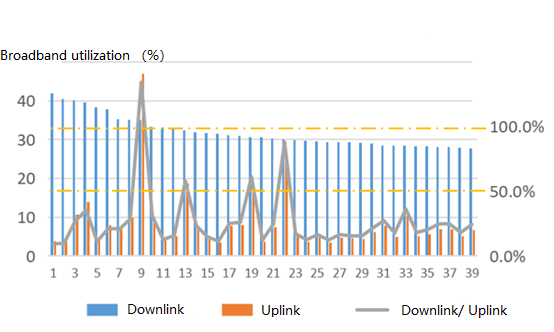
However, the needs of users are diverse. With the rise of services such as live broadcast and video surveillance, there are more and more scenarios where users pay more attention to the upstream bandwidth, while the private line for inbound customers needs to provide symmetrical upstream/downstream circuits. These services promote the demand for XGS-PON. Being a PON solution, XGS-PON benefited from the efficiencies of a point-to-multipoint architecture but enabled operators to assure Gigabit and multi-Gigabit speeds to end subscribers.
2. XGS-PON Standard
The XGS-PON standard, established in 2016 under Recommendation ITU-T G.9807.1, defines a 10-gigabit capable symmetric passive optical access network. It encompasses residential, business, mobile backhaul, and various applications. Building upon the G-PON evolution, it utilizes elements from the earlier XG-PON physical layer standard, allowing the same optical transceiver components to be employed for both XG and XGS-PON. Leveraging protocol layer standards from NG-PON2 (ITU-T G.989.3), it establishes a comprehensive framework for symmetrical 10-Gbps connectivity.
3. XGS-PON vs NG-PON2
NG-PON2 is considered a potential advancement in service and network capacity, employing time and wavelength division multiplexing (TWDM) to enable four or more simultaneous 10 Gbps transmissions over the same fiber, totaling a symmetrical capacity of 40 Gbps. In contrast, XGS-PON, following the G-PON lineage, operates at dedicated upstream and downstream wavelengths. While NG-PON2 boasts impressive bandwidth potential, its deployment involves higher initial costs due to the need for multiple fixed or tunable optics at both ends of the line, unlike XGS-PON.
The variable wavelength capability of NG-PON2 through TWDM allows service overlays on existing G-PON or XGS-PON installations, as its allocated wavelengths don’t overlap with either. Both XGS PON and NG-PON2 utilize higher/longer (>1550 nm) downstream wavelengths, inherently more susceptible to power loss from fiber macrobending attenuation.
4. XGS-PON OLT
In any PON standard, including XGS-PON, the optical line terminal OLT is crucial, situated in the service provider’s local office. Functioning as the active hardware, the OLT converts and transmits data, coordinating the multiplexing of optical network terminals ONT at the network’s end. The XGS-PON OLT efficiently broadcasts data to all ONTs in the network through passive downstream optical splitters. Each ONT determines the relevant data. Virtualized OLTs can be programmed for traffic delivery over various PON technologies, enhancing flexibility. The OLT’s split ratio flexibility enables a single XGS-PON OLT to operate multiple PON optical distribution networks ODNs.
5. XGS-PON ONT
Using single or cascaded optical splitters, the OLT’s downstream wavelength in XGS-PON can serve up to 128 end devices (ONT). As per IEEE standards, the ONT is referred to as the optical network unit ONU. Recent advancements in packaging, optics, and chip design have significantly reduced the cost of 10G ONTs, approaching levels comparable to 1G ONTs/ONUs. Increasing economies of scale will drive efficiencies as XGS-PON deployment accelerates. Newer generation XGS-PON ONTs offer enhanced flexibility, allowing FTTH, business, and 5G applications to share common hardware elements.
6. Coexistence of XGS-PON, XG-PON and GPON
XGS-PON is the technical evolution of GPON and XG-PON and has proven as reliable fiber network for delivering high-speed broadband service. It supports the hybrid access of three types of ONUs, GPON, XG-PON and XGS-PON.
6.1 Coexistence of XGS-PON and XG-PON
Like XG-PON, the downlink of XGS-PON adopts broadcast mode, and the uplink adopts TDMA mode.
Since the downstream wavelength and downstream rate of XGS-PON and XG-PON are the same, the downstream of XGS-PON does not distinguish between XGS-PON ONU and XG-PON ONU. The optical splitter broadcasts the downlink optical signal to each XG(S)-PON (XG-PON and XGS-PON) ONU in the same ODN link. Each ONU chooses to receive its own signal and discards other signals.
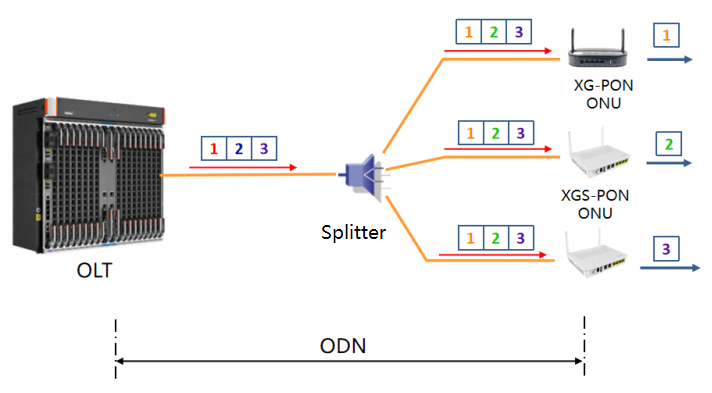
The upstream of the XGS-PON transmits data according to the time slot, and the ONU sends the data in the time slot permitted by the OLT. The OLT dynamically allocates time slots according to the traffic requirements of different ONUs and the type of ONUs (either XG-PON or XGS-PON). In the time slot allocated to the XG-PON ONU, the data transmission rate is 2.5 gbps; in the time slot allocated to the XGS-PON ONU, the data transmission rate is 10Gbps.
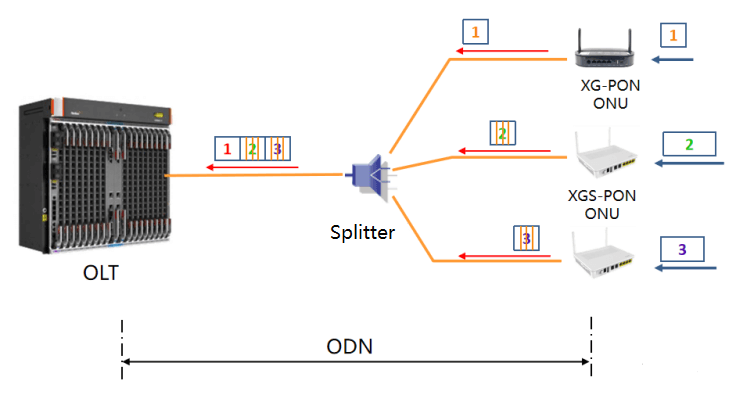
It can be seen that XGS-PON supports hybrid access with two ONUs, XG-PON and XGS-PON.
6.2 Coexistence of XGS-PON and GPON
Since the uplink/downlink wavelengths are different from GPON, XGS-PON adopts the Combo solution to share ODN with GPON.
The Combo optical module of XGS-PON integrates GPON optical module, XGS-PON optical module and WDM combiner.
In the upstream direction, after the optical signal enters the XGS-PON Combo port, the WDM filters the GPON signal and the XGS-PON signal according to the wavelength, and then sends the signal to different channels.
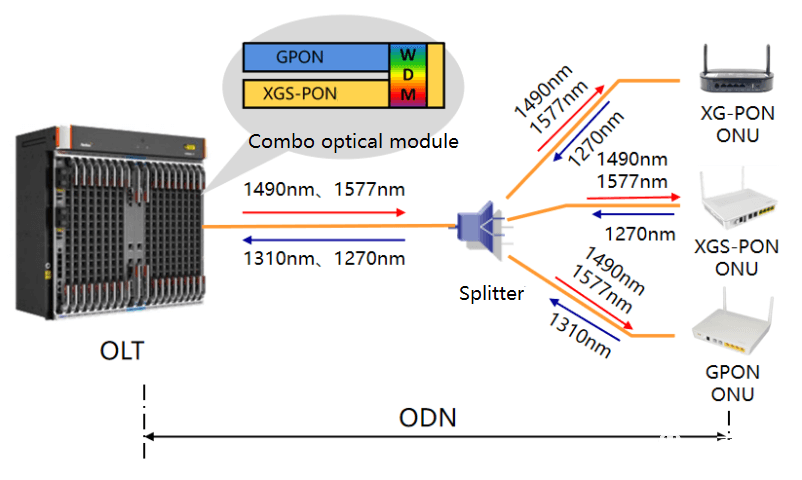
In the downstream direction, the signals from the GPON channel and the XGS-PON channel are multiplexed through WDM, and the mixed signal is downstream to the ONU through the ODN. Due to the different wavelengths, different types of ONUs select the required wavelength through the internal filter to receive the signal.
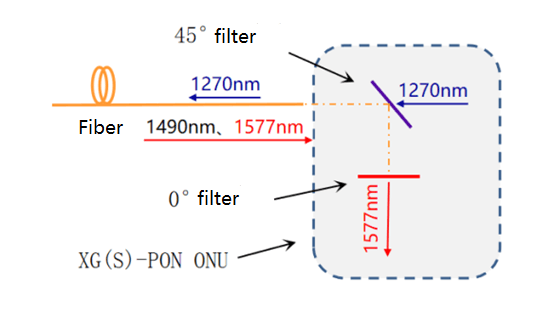
Since XGS-PON supports coexistence with XG-PON, the Combo solution of XGS-PON supports the mixed access of three types of ONUs, namely GPON, XG-PON and XGS-PON. The Combo optical module of XGS-PON is also called three Mode Combo optical module (the XG-PON Combo optical module is called a two-mode Combo optical module because it supports the mixed access of GPON and XG-PON ONUs).
7. At the End
Affected by equipment cost and equipment maturity, currently, the equipment price of XGS-PON is generally much higher than that of XG-PON. Among them, the unit price of OLT (including Combo user board) is about 20% higher, and the unit price of ONU is more than 50% higher.
Although the inbound private line needs to provide symmetrical uplink/downlink circuits, the actual traffic of the vast majority of inbound private lines is still dominated by downlinks. Although there are more and more scenarios where users pay more attention to the upstream bandwidth, there is almost no service that cannot be accessed through XG-PON and must be accessed through XGS-PON.
Due to the good compatibility of the XGS-PON Combo solution, the unit price of the XGS-PON OLT (including the Combo user board) is not much higher than that of the XG-PON, and a small amount can be deployed in large cities (where the upstream traffic of the headquarters of the passenger dedicated line is usually high). XGS-PON OLT equipment and XGS-PON ONU are equipped according to the actual online bandwidth requirements of users.




